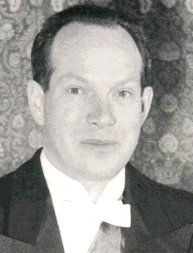
About Andrew Cusack
 Writer, web designer, etc.; born in New York; educated in Argentina, Scotland, and South Africa; now based in London.
Writer, web designer, etc.; born in New York; educated in Argentina, Scotland, and South Africa; now based in London. read more
News
Blogs
Reviews & Periodicals
Arts & Design
World
France
Mitteleuropa
Knickerbockers
Argentina
The Levant
Africa
Cape of Good Hope
Netherlands
Scandinavia
Québec
India
Muscovy
Germany
Academica
‘The Pope: A Portrait from Life’
 LAST NIGHT I finished reading ‘The Pope: A Portrait from Life’ by Constantine, Prince of Bavaria, about Pope Pius XII (who I thought had already been beatified, but not yet). It is definitely one of the biographies I have most enjoyed, perhaps even most enjoyed. The book’s strength lies not in academic depth nor in attention to detail but in giving the reader a great insight into the great man who Pius XII was. From his brilliant diplomacy, working for peace during the First World War under Pope Benedict XV, warning of the dangers of National Socialism as nuncio to Germany under Pope Pius XI, his own accession in 1939, and his tireless efforts to give shelter to all who were in need: Socialists, Communists, Jews, Christians, Atheists, Liberals, Royalists, Republicans, escaped Allied prisoners of war, and after the war, fascists, collaborators, Germans, and others whose lives (and souls) were equally in danger. There was no barrier of race or religion or party or ideology. Indeed, the Grand Rabbi of Rome, sheltered by Pius XII during the war was so inspired by him that three years after the war ended, he became a Christian, taking the name ‘Eugenio’, Pius’s birth name.
LAST NIGHT I finished reading ‘The Pope: A Portrait from Life’ by Constantine, Prince of Bavaria, about Pope Pius XII (who I thought had already been beatified, but not yet). It is definitely one of the biographies I have most enjoyed, perhaps even most enjoyed. The book’s strength lies not in academic depth nor in attention to detail but in giving the reader a great insight into the great man who Pius XII was. From his brilliant diplomacy, working for peace during the First World War under Pope Benedict XV, warning of the dangers of National Socialism as nuncio to Germany under Pope Pius XI, his own accession in 1939, and his tireless efforts to give shelter to all who were in need: Socialists, Communists, Jews, Christians, Atheists, Liberals, Royalists, Republicans, escaped Allied prisoners of war, and after the war, fascists, collaborators, Germans, and others whose lives (and souls) were equally in danger. There was no barrier of race or religion or party or ideology. Indeed, the Grand Rabbi of Rome, sheltered by Pius XII during the war was so inspired by him that three years after the war ended, he became a Christian, taking the name ‘Eugenio’, Pius’s birth name.
‘The Pope: A Portrait from Life’ tells the story of Eugenio Pacelli with anecdotes and stories from all the people surrounding this, the most lied-about figure in the history of the twentieth century. I strongly recommend this book to anyone interested in the life of Bl. Pius XII. It is almost cinematic as it moves from scene to scene, from the present (Rome 1954) to the past, in Rome, in Germany, in America over the years of Eugenio Pacelli’s career as priest, churchman, diplomat, and finally pontiff.
Constantine himself (pictured above) is interesting in his own right. Born in 1920, with all the Royal House of Wittelsbach he was kicked out of the German Army by Hitler and, in 1944, arrested by the Gestapo. Liberated by the French, he went on to work for the International Red Cross, until 1947 when he went to work in the Munich office of the Associated Press. In 1950, he became editor of Germany’s Revue magazine, and was later elected to the Bundestag. Unfortunately, he died in an air crash in 1969. This book as evidence of Contantine’s adroitness in the journalistic profession. It is no longer in print, sadly, and so hard to find, but if you do ever happen to come across it, buy it, read it; you will not be disappointed.
Search
Instagram: @andcusack
Click here for my Instagram photos.Most Recent Posts
- Silver Jubilee November 21, 2024
- Articles of Note: 11 November 2024 November 11, 2024
- Why do you read? November 5, 2024
- India November 4, 2024
- The Lithe Efficiency of the Old Constitution November 4, 2024
Most Recent Comments
Book Wishlist
Monthly Archives
Categories



Mr. Cusack: Have you by any chance read John Cornwell’s book, Hitler’s Pope, about Pius XII? Despite his initial intentions to write a book along the lines of what you describe above, he ended up finding documentation that suggested that Pius was anything but the equality-minded giver of shelter apparently depicted by Prince Constantine. I haven’t read the prince’s book, but wonder if he might have lacked access to the Vatican archives used by Cornwell to inadvertently draw a conflicting portrait.
Thankfully, a number of scholars have demolished the case Cornwell made in his book. Unfortunately, Cornwell’s book was intended for a popular audience, and was happily seized by the media and given much publicity. The refutations, some of which have tended toward the more scholarly, have not been given the same level of attention.
Two of the more popular refutations are The Myth of Hitler’s Pope by Rabbi David G. Dalin, and Pope Pius XII by Sister Margherita Marchione, who has devoted much of her time and efforts to clearing the name of this great and holy man.